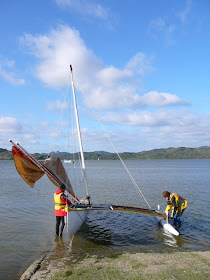 | ||
| Gary's Va'a Motu with Harmen Hielkema and Gary Dierking in Coromandel. Photo by Julie Holton |
We had a light easterly blowing offshore, though a local rotor around the headland (in the background) meant beating off the beach for the first stage of the trip. I got to steer!
The waka has a voluminous hull which accommodates the two of us comfortably with no noticeable loss of performance. With the main and jib sheeted home the waka slides through the water with barely a trace of a wake and very little noise. I immediately took to the feel of this sail boat, very slight weather helm, just how I like it, everything positioned just where it should be.
The rudder in its cassette is very easily reached and manipulated. I particularly like this solution for shallow water sailing as the blade remains partially retracted in it's correct position to maintain control as you leave or approach the beach. A taught bungy restraining cord allows for partial blade displacement out of the case during any accidental grounding.
The main sheet is arranged by a network of leech bridles, much like a junk sail, which provides excellent support and control for the boomless, full battened mainsail.
The Jib features a luff wire which is connected top and bottom to a swivel furling system, allowing for immediate dousing of the head sail.
 | |
| Gary's home made roller furling set up on his Va'a Motu |
Gary and I headed for a beach up wind on the far side of the Harbour. Gary had noticed a non responsive GPS screen which he needed dry land to attend to. On starboard tack the ama sits to leeward so we were in trimaran mode as Gary likes to call it, with the ama taking the full share of the righting moment. There was however enough wind to allow me to ride on the windward lounger chair with it's poly canvas back support, great for an old codger like me. I don't think that I've ever been so comfortable on a small sail boat before, in fact I know I haven't!
Reaching the beach amidst a number of curious but uncomprehending onlookers, Gary whipped out the GPS from its watertight bulkhead compartment but was unable to make anything happen.
Being a perfect luddite I couldn't care less about no GPS and I was eager to get moving again. Gary took over control of the mainsheet to make me even more comfortable. and proceeded to put on his sailing gloves, one of which dropped over the side unnoticed. Once the glove was missed I suggested we run back down the trail of bubbles to retrieve it so we gibed around and retraced our wake, there sure enough was the floating glove. Gary asked me to steer so he could easily retrieve it, got it with pin point accuracy. He needn't have said a word, this canoe goes exactly where you want it to!
Gybing back around we set off across the harbour steadily easing sheets until we were broad reaching through the largest flock of black swans I have ever seen. Startled they all took to the air simultaneously. They are comical to watch as they literally run on the water with their necks out streached, working their wings furiously as they struggle to get their full bellies airborne. The massed sound of the clapping of their webbed feet sounded like an audience applauding.
We harden up on the wind when we finally run out of water and we sail back out of the bay across a commercial oyster farm. This waka tacks effortlessly through a true 90 degrees which makes Va'a Motu as weatherly as any small boat I've sailed. We had a brief moment when a roll to windward reminded us both that we are not as agile as we once were. Gary's sponson "trainer wheel" was always a reassuring back up once the ama came out to windward on port tack.
We investigated and discussed the merits of various ocean going yachts moored in Coromandel Harbour before we finally turned our bow toward home in anticipation of a late lunch and a cold boutique beer of which we are both very fond.
Our rudder clumped into a submerged oyster bag as we approached Gary's slipway with nothing more that a light scratch to tell the tale, roll up the jib and I stepped off the bow into ankle deep water ready to settle the waka on to it's tiny dolly wheels ready to pull a surprisingly light load up the beach and on to the grass of Gary and Rose's back lawn.
 |
| Va'a Motu on Gary and Rose's back lawn. |
This trip serves to remind me just how much I love yachting, particularly on a waka and most particularly with a close friend who's sailing skills match my own perfectly.
Thanks Gary.














































